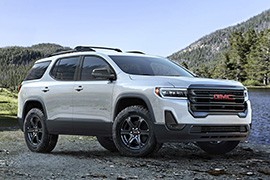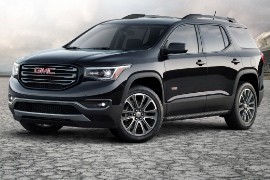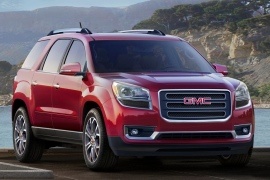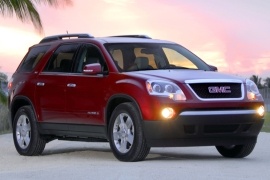GMC Acadia Models/Series Timeline, Specifications & Photos
First production year: 2007
Engines: Gasoline
Body style: SUV (Sports Utility Vehicle)
GMC introduced the second generation of the Acadia in 2016 at the North American International Auto Show, but just three years later, it unveiled a facelifted version for the 2020 model-year.
Based on the same platform as the Cadillac XT6 and the Chevrolet Blazer, the Acadia was a mix between these vehicles in terms of quality and refinement. Moreover, its upscale amenities were concealed behind a mundane look and a badge often seen on utility vehicles. But it was more than that.
The front fascia had been heavily revised, and for the 2020 model-year it sported new headlights adorned with C-shaped daytime running lights. A broad grille with chromed double slats, or just two slats, depending on the options, let the customers know that it was not just another ordinary SUV. The Denali version even featured a lower chromed trim on the bumper and apron. From its side, there were minimal changes to the vehicle.
Inside, it was a different story. GMC installed a new infotainment system that was Apple CarPlay and Android Auto compatible. In addition, the automaker offered a head-up display for it, helping the drivers to keep their eyes on the road. The car was available in four trim levels starting with the SLE at the bottom and ending up with the luxurious Denali. Customers could order the vehicle in a five or seven-seat configuration.
GMC added another engine under the 2020 Acadia's hood, namely a 2.0-liter turbocharged gasoline unit. All versions were mated to a nine-speed automatic transmission that replaced the older six-speed gearbox used on the non-facelifted version.
Despite the general trend to increase the car's dimensions, the 2017 GMC Acadia decreased its dimensions when compared with its predecessor. But that didn't make it a small SUV.
The 2017 Acadia left the older chassis-based platform and adopted the C1XX platform that was also used for the Chevrolet Blazer or the Cadillac XT5. But despite its size reduction, it kept the three-row seating.
On the outside, the blindingly shiny, chromed-plastic grille might be too much for the front fascia. It looks like the design team ran out of ideas and used all the chromed parts they had in stock. The HID headlights were available only for the top version, but the lesser version had halogen-projector lamps. Looks like the GMC didn't discover the LED lights for SUV vehicles, or that the Acadia wasn't important enough for the market.
Inside, woodgrain imitation and aluminum plastic were all over the place, imitating a luxurious cabin. The man-made leather seats (or ecological leather as it was known) were part of the complete image of an outdated design launched a decade too late. But the 8" touch-screen for the infotainment system was placed in the proper place, on top of the center console. It featured Android Auto and Apple CarPlay.
For the drivetrain, the Acadia was available with an inline-4 engine or a V6 mated to a standard 6-speed automatic gearbox. It was available as an RWD or AWD.
After the dismissal of the Saturn brand, GMC had to fill in the gap in its product lineup and made the Acadia a badge-engineered version of the Chevrolet Traverse and Buick Enclave.
Automakers are planning their production in advance, even from the early stages of car development. In order to get its first unibody seven-seat CUV, GMC had to sell a certain number of those, and it didn't think that with only two brands, it could do it, so it sold it also as the Acadia. Moreover, it offered the vehicle available in five trim levels, so people could get the one they wanted. But sales struggled to pass the 80,000 units mark ever since the model's launch in 2006, so GMC refreshed the vehicle in 2012 for the 2013 model-year, and results followed with sales closing, end even exceeding the 90,000 units mark.
The refreshed 2013 version came with a bold-looking front fascia where the grille was widened compared to the non-facelifted version. In addition, the headlights were taller and slightly swept back to the sides and adorned by C-shaped daytime running lights. In addition, the Denali trim level featured more chromed trims, which added a luxurious look.
Inside, drivers could get up to seven other passengers with them since the Acadia was a three-row vehicle. Still, depending on the options, the carmaker could make the car with six individual seats, which added more comfort for everyone onboard. The dashboard featured a simple yet effective layout, with an instrument cluster clearly arranged where a clock took center stage that was perfect for school runs. A head-up display was also available. On the center stack, GMC added a touchscreen infotainment system with a rear-view camera.
Just like its siblings, the Acadia was available with either a front or an all-wheel drive system. Under the hood, the automaker installed a 3.6-liter V6 paired with a six-speed automatic fitted as standard on the entire range. The all-wheel drive system was on the list, while those who didn't need that could get the car as a front-wheel drive affair.
GMC Introduced the Acadia in 2006 as a 2007 model, and it was the company's first-ever passenger vehicle that featured a front-wheel-drive, even though it was dressed as an SUV.
When GMC launched the vehicle, there were no signs of the world financial crisis that was about to begin and throw the entire motoring industry into chaos, with the Big-Three from Detroit trying to dodge the financial losses bullets. Strangely though, the Acadia was fit for the forthcoming times and offered a lower-priced SUV in a market that begged for that kind of vehicle. Its unit-body construction made the vehicle lighter than the regular 4x4 vehicles on the market. That led to lower fuel consumption as well.
From the outside, the Acadia looked like a regular, classic-looking 4x4, but its softened edges made it appealing to the customers that didn't look for a rugged off-road vehicle. At the front, GMC installed a chrome-plated bar on top of the grille and boomerang-shaped headlights with corner-mounted turn signals. Its long rear windows and the raked-forward tailgate tried to diminish the car's off-road look. Its taillights featured clear lenses on their upper side.
Inside, the seven-seat vehicle was suitable for a family, or two, who wanted to go on long trips. Even with all the seats up, the Acadia still had a decent trunk. With the second and third rows folded down, it provided a long flat area and an astonishing 3,313 liters (117 cu-ft) of space. That was already in LCV territory.
Under the hood, GMC installed a 3.8-liter V-6 engine offered in two power versions: 275 hp (up to 2008) and then increased to 288 hp. Both versions were paired to a six-speed automatic version. GMC offered the Acadia with a front- or all-wheel-drive system.



